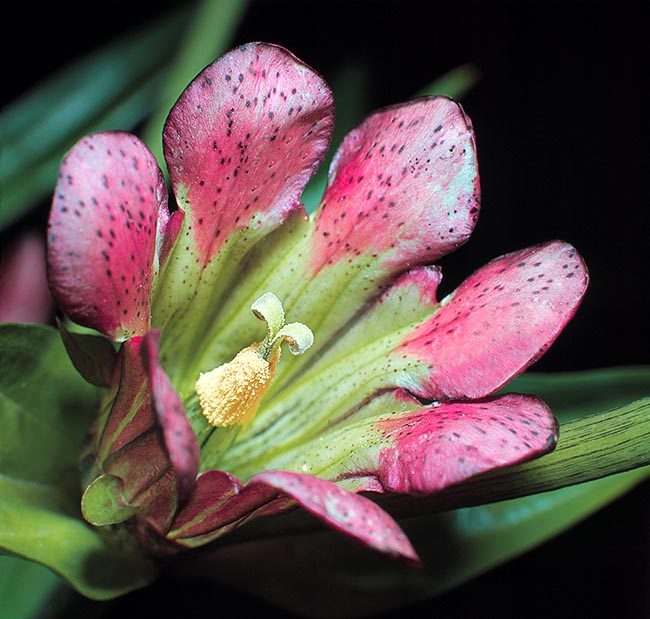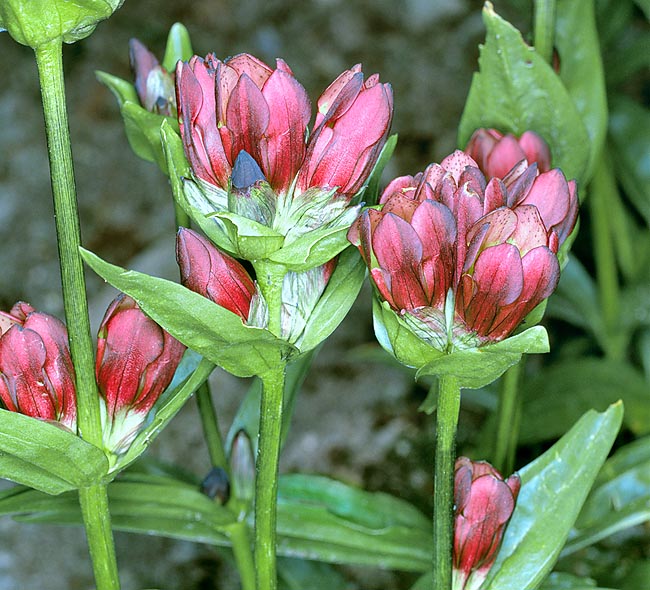Family : Gentianaceae

Text © Dr Barbara Barisani

English translation by Mario Beltramini

Gentiana purpurea smells of honey and has medicinal virtues © Giuseppe Mazza
Common names: Genziana porporina (Italian), Gentiane pourpre (French), Purple Gentian (English), Genciana púrpura (Spanish), Purpur-Enzian (German).
Natural hybrids: Gentiana × spuria Lebert (Gentiana punctata × Gentiana purpurea); Gentiana × hybrida Schleicher ex DC. (Gentiana lutea subsp. lutea × Gentiana purpurea).
The species Purple Gentian (Gentiana purpurea L. 1753) is present in the central sectors of the Alps. Some stations are located in southern Norway and in the Tuscan-Emilian Apennine.
The habitat is formed by meadows, pastures, megaphorbiets, and sub-Alpine shrub-lands. It prefers acidic soil, from (700) 1200 to 2600 m of altitude.
It is a 20-60 cm tall perennial plant. Its stem is erect, simple, robust, hollow, often reddened. It has the scent of honey.
It has petiolate to sessile basal leaves, 4-12 cm long and 1,5-4,5 cm broad, with lanceolate to ovate edge, sharp apex and 5 evident nervations. The cauline leaves are of reduced size and sessile. The flowers are sessile, arranged in fascicles at the apex of the stem or at the axil of the upper leaves. The calyx measures 7-10 mm of length, is membranous and of violet colour. On one side, it is etched down to the base; the teeth are obtuse, apiculate, 4-5 mm long. The corolla is shaped like a bell, up to 3 cm long, of purple-coppery colour, with more or less evident violaceous dotting, streaked with green on the tube, yellowish inside.

20-60 perennial plant, has bundled sessile flowers at the stem or at the upper leaves axil © Giuseppe Mazza
The fruit is an ellipsoidal-obovate capsule. The seeds are numerous, brown-yellowish, winged.
It is possible to cultivate the Purple gentian, providing it is inserted in habitats having a climate suitable to its ecological requirements. In the rocky garden as well as in full earth, it needs aerated, fresh, deep and well drained soil. It multiplies by seed, cutting or by division of tufts.
The plant is utilized in pharmacopoeia, in herboristery and in the liquor industry. Like other species of the same family, it contains secondary metabolites responsible of the sour taste (xanthones, alkaloids, glycosidic iridoids).
In the traditional medicine the roots and the rhizomes are used for preparing liquors and bitter, tonic alcohol-free drinks, stimulant of the appetite and the functions of the liver and of the gallbladder. It is also used in the cases of sideropenic anaemia (iron deficiency). Externally, is used for treating wounds and as active substance in the medicines for smoking cessation. The use of the gentian is not recommended in pregnancy, during breastfeeding and in the cases of hypertension.
Synonyms: Pneumonanthe purpurea Schm.; Coilantha purpurea (L.) Borkh.; Pneumonanthe purpurea (L.) F.W.Schmidt; Gentianusa purpurea (L.) Pohl.
→ To appreciate the biodiversity within the GENTIANACEAE family please click here.
